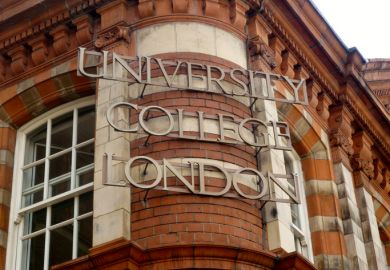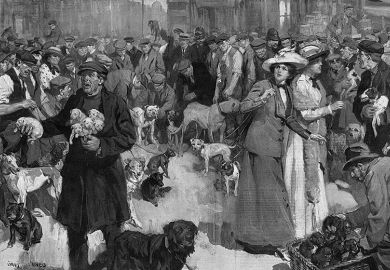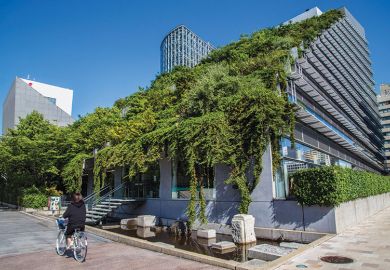The City of London's Royal Exchange is the London Topographical Society's choice of subject for its 1997 publication. This attractive, well-bound volume is number 152 in a long and interesting range on London and its built environment. Some 30 contributors cover a quite ample range of subjects, from the broad narrative of the development of the Royal Exchange through to finer points of detail, ranging from wills left by early shopkeepers to scurrilous goings-on at the Royal Exchange tea-rooms during the first world war. This is not intended to be an exhaustive history, even though the content is broadly chronological. Each phase in the Exchange's history is allotted a section, within which are erudite articles on the building, the people who used it and the events that it witnessed. There are appendices and a chronology, but rather frustratingly there is no bibliography, largely because of the dearth of specific material available.
The Royal Exchange is not perhaps as widely known today as it deserves. It occupies a prime site alongside the Bank of England, in full view of the Mansion House, bordered by Cornhill and Threadneedle Street. It is hardly surprising that a building in such a location should also be a microcosm of the City's history since its foundation by the Elizabethan financier Sir Thomas Gresham in 1566 as a counterpoint to the Bourse in Antwerp, which had opened 30 years earlier and had become a focus for European trade.
Gresham came from a family which had distinguished itself in commerce. Sir Thomas acted as an agent on behalf of the Crown and lived in Antwerp for some years. It was this experience plus the longstanding ambition of his father to establish a bourse in London that led him to propose building an exchange in return for a lifetime interest in it, if the City Corporation would provide the land. It also could have served as a way of keeping his name alive, since his only son had been killed in a riding accident shortly before.
The terms and conditions of the arrangement proved to be far more complex than the actual construction of the building, which was erected in Flemish style (with a few Italianate flourishes) by workers brought over from Antwerp, using locally dressed stone, much to the annoyance of the Bricklayers' Company of London. The finished building was impressive; so much so that Queen Elizabeth I graciously named it the Royal Exchange when she came to visit in 1571. At the time few of the 120 shops that ran around the two galleries (or Pawns) were tenanted, but these and some adjacent property were designated to provide the income for maintenance and running costs. Traders were permitted to use the courtyard for their transactions, which drew people from all over the mercantile world. Even so, income was not at first significant, a situation not helped by Sir Thomas's desire to found a college that this time would bear his name. Under the terms of his will, Gresham College was to be created on the death of his wife, who fought hard to the have the will overturned. Fortunately for the City she failed, and Sir Thomas's two great projects, the Royal Exchange and college, both took root.
The significance of the Exchange may be seen by the speed with which it was rebuilt after the Great Fire of 1666. Unfortunately it was unable to attract sufficient tenants, as many people had begun to rebuild outside the immediate City area. By 1719 it had found a new purpose with corporate rather than private tenants. Royal Exchange Assurance moved in, providing a focus for the insurance business, a connection that has survived to the present day. The need for information (always a City concern) had led to the regular publication of commodity prices, and that in turn encouraged the concentration of booksellers and purveyors of information, not as well-known perhaps as those around Fleet Street or St Paul's Churchyard, but pivotal for the shops in the vicinity that concentrated on books, maps and (a logical progression) the making of precision instruments. Much of this activity focused on the coffee shops (like Edward Lloyd's in Lombard Street) which proliferated in response to the volume of local activity and the role of the exchange in maritime activities. Shipping details were published there, cargo space arranged, and the East India Company even used the vaults at one time for storage.
The fate of the Royal Exchange was called into question again, in 1838, because of fire and the changing needs of the City population. The challenge of redeveloping key City space combined with the spirit of the early Victorian era to call for a building of suitable grandeur, on a traffic island complete with road-widening schemes, and orientated towards the West rather than the South. The resulting open competition was a classic example of the shortcomings of public planning at the time. There was conflict with the Treasury over the use of public funds to pay for it, while City interests were concerned at government interference. It was seven years before William Tite's elegant neoclassical building opened, and almost 40 years before the central courtyard was glassed over, by which time the Royal Exchange had lost its pre-eminence as a trading centre, except for Lloyd's, and even it moved out in 1928. During the second world war (from which it emerged unscathed) it was used for concerts and even housed the Mermaid Theatre for a while.
As a grade one listed building, the Royal Exchange also survived the modernising attentions of the developers, but its future was uncertain until Guardian Royal Exchange bought it for their headquarters. The spacious courtyard was used to launch the London International Financial Futures Exchange (LIFFE), which operated for nine years (until the move to Cannon Street in 1991) in a curious structure lodged inside the main walls. It seems quite regrettable that a space large enough to have hosted concerts for 1,000 people in the 1940s and to have housed an entire theatre in the 1950s should have been left fallow for quite so long. There are still shops (looking outwards rather than inwards, as before) and the building is still topped by a flagpole bearing the golden grasshopper of the Gresham family, though Guardian Royal Exchange has avoided using the grasshopper in its logo, apparently because some overseas clients misread it as a locust.
The range of illustrations in the book are nothing short of remarkable - almost 300, in colour as well as black and white. They include a set of triumphal murals depicting episodes in English history, which will be familiar as they were used from 1913 right up to the 1950s as standard illustrations in school history books. A closer examination, however, will reveal a political element regarding the future of the City of London, and its ability to ward off attempts to control its independence and authority. The images (like Richard III being offered the crown at Baynard's Castle) were all designed to show the power of the City and to emphasise the extent to which it has struggled in the past to gain and maintain its rights. From the Great Refusal of the 1630s through to the Great Awakening of the livery companies in the 1870s, from the London Corporation bills of the 1850s to Herbert Morrison and the LCC, the City of London has faced threats to its existence. It is perhaps apposite that this handsome volume on the Royal Exchange should appear at a time when the future governance of the Square Mile is again under discussion.
Tim Connell is professor of languages for the professions, City University, London.
The Royal Exchange
Editor - Ann Saunders
ISBN - 0 902 087 38 X
Publisher - London Topographical Society
Price - £45.00
Pages - 444
Register to continue
Why register?
- Registration is free and only takes a moment
- Once registered, you can read 3 articles a month
- Sign up for our newsletter
Subscribe
Or subscribe for unlimited access to:
- Unlimited access to news, views, insights & reviews
- Digital editions
- Digital access to THE’s university and college rankings analysis
Already registered or a current subscriber? Login



